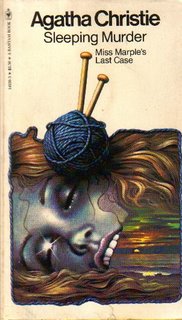 First published in 1976; cover shown is the 1981 Bantam Books (USA) paperback. Cover art by Tom Adams.
First published in 1976; cover shown is the 1981 Bantam Books (USA) paperback. Cover art by Tom Adams.During the Second World War Agatha Christie wrote two books that were to be published posthumously. One was Curtain, the final Poirot novel. At the end of this novel the elderly, wheelchair-bound Poirot (who has sadly lost his famous moustache and now has a fake one) dies, and only then does the faithful Hastings discover the sad truth about Poirot's last case.
While Curtain was ultimately published shortly before Christie's death, Sleeping Murder, the second of the two books, was saved for its original purpose of posthumous publication. Sleeping Murder is the final Miss Marple mystery, but she is fortunately allowed to keep her dignity and survive past the finale of the book.
Gwenda Reed has just purchased a home for herself and her new husband in South Devon. From the first moment she sees the house she feels certain it should belong to her; walking through it she finds she already knows where the bedrooms are and what colour the original wallpaper of a particular room was. When she attends a performance of The Duchess of Malfi in London, a line in the play (Cover her face; mine eyes dazzle; she died young) brings back a sudden, clear memory of looking through a staircase railing and seeing a strangled woman named Helen lying on the floor.
Gwenda is certain she is going insane, as she was brought up as an orphan in New Zealand and had not set foot in England until recently. The aunt of friends in London - a certain Miss Jane Marple - offers a different solution to the unsettling occurrences. Isn't it possible that Gwenda lived in South Devon while she was a child and too young to consciously remember doing so? Gwenda writes to a relative in New Zealand, and soon knows the truth. Brought back from India as a toddler by her widowed father, Gwenda lived in the house she has just purchased until the age of three or so, when her new stepmother ran away with a lover and her father admitted himself to a sanatorium.
So if Gwenda's flashbacks are true, then was the young woman she saw lying dead on the floor really her stepmother Helen, and was her own father (now long dead) responsible? With the help of her husband Giles, Gwenda begins investigating this 18 year old "sleeping murder". Miss Marple, apprehensive about the consequences of this investigation, travels to South Devon and is soon helping the young couple. And it's good that she does, as out of the many people Gwenda and Giles talk with (Helen's much older brother, Helen's would-be lovers, former servants), one of them does not want the truth uncovered... and he has no qualms about killing again.
This was a surprisingly good read. I had actually never read it, thinking that as it was one of Christie's last novels it would be like Passenger to Frankfurt or Third Girl: not very good. But discovering that it was actually written in the 1940s meant that I recently gave it a chance - and enjoyed it immensely! It has all the elements of a really good Christie, including that very real sense of evil throughout.
No comments:
Post a Comment